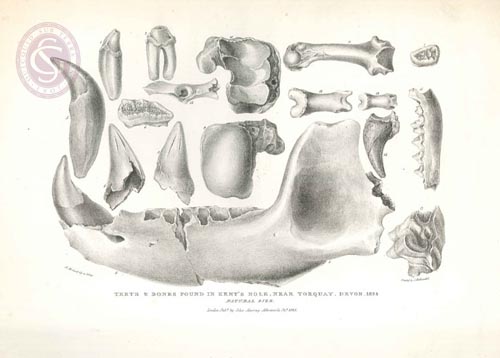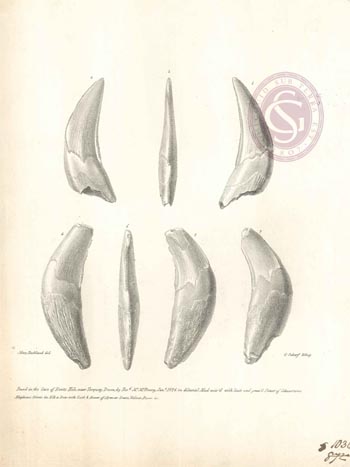Lithographs of teeth and bones found in Kent's Hole, 1825-[1829]
 |
Lithograph of 'Teeth and bones found in Kent's Hole, near Torquay, Devon, 1824', by Mary Morland [later Mary Buckland], printed by Charles Hullmandel and published by John Murray, 1825. (LDGSL/56/1/5/1)
Lithograph, 'Teeth found in the cave of Kent's Hole, near Torquay, Devon by Reverend Mr McEnery, January 1826 in diluvial Mud mix'd with Teeth and gnaw'd Bones of Rhinocerus, Elephant, Horse, Ox, Elk and Deer with Teeth & Bones of Hyaenas, Bears, Wolves, Foxes, &c', by George Scharf after Mary Buckland, [1827-1829]. (LDGSL/56/1/5/2)
 |
As a skilled natural history artist, Mary provided illustrations for a number of her husband’s works. These two prints were probably produced for inclusion in William Buckland's projected second volume of his influential treatise, 'Reliquiae Diluvianae' (1823). The original volume detailed his analysis of the behaviours of extinct animals found in Kirkdale Cavern, Yorkshire, but was still heavily influenced by biblical interpretations of geology.
Between 1825-1829, Kent’s Cavern in Torquay, Devon, was excavated by the Reverend John MacEnery who had found similar extinct animals alongside evidence of hominid activity. MacEnery invited Buckland to join him, however the two men did not agree on the coexistence of the fossil faunas found in the cave. Buckland believed the extinct animals were antediluvian – that is existed prior to the biblical flood – the humans appearing later.